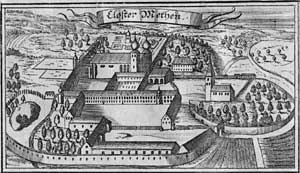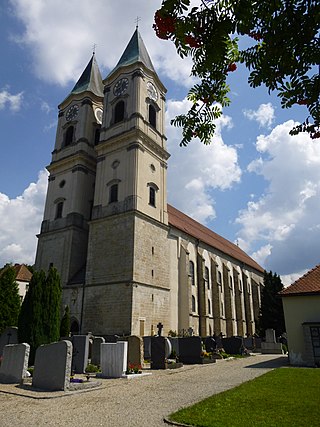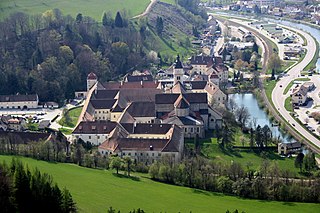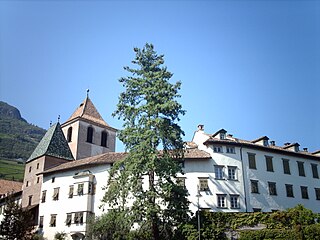
Michaelbeuern Abbey (German : Abtei Michaelbeuern) is a Benedictine monastery in Dorfbeuern near Salzburg in Austria.

Michaelbeuern Abbey (German : Abtei Michaelbeuern) is a Benedictine monastery in Dorfbeuern near Salzburg in Austria.
A monastic cell existed here as early as 736 or thereabouts, referred to in the Aachen Monastery Register("Klosterverzeichnis") in 817 as "Buria". After the Hungarian wars, reconstruction began in 977 with an endowment from Emperor Otto II. More times of crisis came upon the abbey with the fire of 1346, mismanagement of the prebendal income and the effects of the Reformation.

From the 17th century however Michaelbeuern began a long period of prosperity, which led to ambitious building works, for example the Baroque high altar of 1691 in the abbey church, by Meinrad Guggenbichler and Johann Michael Rottmayr. At this time more than twenty-five monks of Michaelbeuern gained their doctorates at the Benedictine University of Salzburg. The community also took on many pastoral responsibilities in the surrounding parishes. During the National Socialist period the monks were expelled, but returned after World War II. The abbey church, re-romanised, was re-dedicated in 1950.
From 1641 the abbey was a member of the Salzburg Congregation, which in 1930 was merged into the present Austrian Congregation of the Benedictine Confederation.
The abbey today is a thriving Benedictine community, well known as an educational and cultural centre. The abbey runs a school and owns different business like a farm, a district heating plant, a biogas plant and a participation in a brewery (Augustiner Bräu Kloster Mülln). Cultural offerings include the Baroque cloister, medieval refectory, and high altar in the church. The abbey houses a rich manuscript collection, a notable music archive, and hosts various concerts. It actively preserves and presents Christian art within the monastic community. [1] The present abbot is Johannes Perkmann who was elected in 2006.

Melk Abbey is a Benedictine abbey above the town of Melk, Lower Austria, on a rocky outcrop overlooking the Danube river, adjoining the Wachau valley. The abbey contains the tomb of Saint Coloman of Stockerau and the remains of several members of the House of Babenberg, Austria's first ruling dynasty.

Einsiedeln Abbey is a Catholic monastery administered by the Benedictine Order in the village of Einsiedeln, Switzerland.

The Schottenstift, formally called Benediktinerabtei unserer Lieben Frau zu den Schotten, is a Catholic monastery founded in Vienna in 1155 when Henry II of Austria brought Irish monks to Vienna. The monks did not come directly from Ireland, but came instead from Scots Monastery in Regensburg, Germany. Since 1625, the abbey has been a member of the Austrian Congregation, now within the Benedictine Confederation.

Metten Abbey, or St. Michael's Abbey at Metten is a house of the Benedictine Order in Metten near Deggendorf, situated between the fringes of the Bavarian Forest and the valley of the Danube, in Bavaria in Germany.

The Abbey of Our Lady of Zwiefalten, more commonly known as Zwiefalten Abbey is a former Benedictine monastery situated at Zwiefalten, near Reutlingen, in the German State of Baden-Württemberg. Zwiefalten lies on the touristic Upper Swabian Baroque Route. The abbey church is a major example of baroque architecture.

Niederaltaich Abbey is a house of the Benedictine Order founded in 741, situated in the village of Niederalteich on the Danube in Bavaria.

Kremsmünster Abbey is a Benedictine monastery located in Kremsmünster, Upper Austria.

Göttweig Abbey is a Benedictine monastery near Krems in Lower Austria. It was founded in 1083 by Altmann, Bishop of Passau. In the middle ages the abbey was a seat of learning with a library and a monastic school. The abbey went through a period of decline during the 15th and 16th centuries and in 1580 it was mostly destroyed by a fire. Under a new abbot brought in from Melk Abbey the monastery was rebuilt and restored. After another fire in 1718 the abbey had to be rebuilt again. The new building includes the largest Baroque staircase in Austria with a fresco that is considered a masterpiece of its era. Today the abbey is renownend for its library which holds a valuable collection of books, manuscripts, coins and antiquities.

Seckau Abbey is a Benedictine monastery and Co-Cathedral in Seckau in Styria, Austria.

Neresheim Abbey or the Abbey of Saints Ulrich and Afra, Neresheim is located above the town of Neresheim in Baden-Württemberg, southern Germany. It is now a Benedictine monastery and is part of the Beuronese Congregation.

Admont Abbey is a Benedictine monastery located on the Enns River in the town of Admont, Styria, Austria. The oldest remaining monastery in Styria, Admont Abbey contains the largest monastic library in the world as well as a long-established scientific collection. It is known for its Baroque architecture, art, and manuscripts.

St Peter's Abbey, or St Peter's Archabbey, is a Benedictine monastery and former cathedral in the Austrian city of Salzburg. It is considered one of the oldest monasteries in the German-speaking area, and in fact the oldest with a continuous history since its foundation in 696.

Mondsee Abbey was a Benedictine monastery in Mondsee in Upper Austria.

Saint Paul's Abbey in Lavanttal is a Benedictine monastery established in 1091 near the present-day market town of Sankt Paul im Lavanttal in the Austrian state of Carinthia. The premises centered on the Romanesque monastery church were largely rebuilt in a Baroque style in the 17th century.
The Austrian Congregation is a congregation of Benedictine monasteries situated in Austria, within the Benedictine Confederation.
Münsterschwarzach Abbey, is a monastery for Benedictine monks in Germany. It is located in Schwarzach am Main, a small market town at the confluence of the rivers Schwarzach and Main in north-eastern Bavaria.

Lilienfeld Abbey is a Cistercian monastery in Lilienfeld in Lower Austria, south of Sankt Pölten.

Wiblingen Abbey was a former Benedictine abbey which was later used as barracks. Today its buildings house several departments of the medical faculty of the University of Ulm. The former abbey is located south of the confluence of the rivers Danube and Iller, south of the city of Ulm in the German state of Baden-Württemberg. Administratively, the former independent village of Wiblingen now belongs to the city of Ulm. The abbey is part of the Upper Swabian Baroque Route.

Muri-Gries Abbey is located in Bolzano, South Tyrol, Italy and was founded in 1845 as an offshoot of the former Muri Abbey in Aargau. It is a member of the Swiss Congregation of the Benedictine Confederation, mostly known for its wine-making.

The Wachau is an Austrian valley with a picturesque landscape formed by the Danube river. It is one of the most prominent tourist destinations of Lower Austria, located midway between the towns of Melk and Krems that also attracts "connoisseurs and epicureans" for its high-quality wines. It is 36 kilometres (22 mi) in length and was already settled in prehistoric times. A well-known place and tourist attraction is Dürnstein, where King Richard I of England was held captive by Leopold V, Duke of Austria. The architectural elegance of its ancient monasteries, castles and ruins combined with the urban architecture of its towns and villages, and the cultivation of vines as an important agricultural produce are the dominant features of the valley.
48°01′13″N13°01′47″E / 48.02028°N 13.02972°E